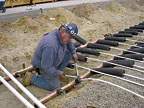
Three years ago, one NFL team learned a costly lesson when their game was cancelled amid furious controversy moments before kickoff. Television images captured the root of the problem when layers of tough artificial turf were peeled back, leaving viewers with the only graphic images from a game that just wasn't going to happen. The fans, managers, and players were livid, TV audiences sulked away, aiming their remotes at other stations, and high-dollar advertisers wanted a refund. Total damage: an $8 million loss in revenue and some measure of embarrassment. It wasn't a good day.
A sports turf professional recently added this insight: "The field is the game's foundation. If it's unsafe, you place the entire franchise at risk. A $20 million QB can fall hard and spend the rest of the season in recovery. Or the field is condemned, posing another threat, one that packs a punch to the team's revenue. The condition of the field can be our worst nightmare, or an answer to dreams."
There's a trend afoot today that has the artificial turf makers on edge: real grass. Lush, living, carefully nurtured and, now, hydronically conditioned turf is all the rage. What gives real turf an advantage, and players the best surface going, lies hidden in the soil where roots receive gentle warmth from miles of pipe that circulate heated fluids.
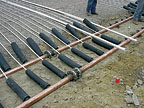
Protecting The Players
One of the newest and most advanced turf conditioning systems is now hard at work under the field at Foxboro's Gillette Stadium, home to last year's Super Bowl champs, the New England Patriots. According to the Patriot's field superintendent, the application of technology to enhance turf performance has "finally come of age."The Patriots' new radiant heating/turf warming system, manufactured by Watts Radiant, uses 153,000 lineal feet, or 29 miles, of cross-linked polyethylene (PEX) pipes that feed warmth to the soil. Kolyn Marshall, engineer for Watts Radiant who designed the intricately piped system for Gillette Stadium, said that turf warming and turf conditioning systems are gaining broad and enthusiastic acceptance in the realm of professional sports, especially turf sports, such as soccer and football. The reason is a growing need to protect a team's investment, the players themselves.
According to Sports Illustrated, at the end of the 2001 season there were over 160 injuries reported in the NFL. Of these injuries 21 were ankle-related and 46 were knee-related. Almost half the injuries can be attributed to turf-related conditions.
Each year, as a playing season progresses, turf conditions deteriorate. Weekly abuse retards the recovery period. New turf is slow to fill in the voids, and exposure to the sun slowly turns soil into something more akin to concrete.
New turf conditioning systems have evolved substantially in just the last few years, and Gillette wanted to keep pace. Dennis Brolin was hired as the stadium's field superintendent in 1996 as the protégé of Pierre Landry, one of the most respected sports turf professionals in the NFL. When Landry moved on, Brolin stepped in. Within months, he was put in charge of a project that would become the most technologically advanced sports turf project to date: the 93,200-sq-ft playing field at Gillette Stadium, located 20 miles south of Boston.
Brolin (who has since left the Patriots field staff) and others at Gillette moved deliberately to research the technology. He visited experts, hit the books, spoke with manufacturers and installers, and took trips to turf-conditioned NFL fields in Baltimore, Cleveland, Green Bay, and Cincinnati.
What The Experts At Gillette Found
Even with new developments in irrigation and soil management, the ability to grow turf is directly related to the condition (and more specifically, the temperature) of the root zone. Constant root zone temperatures help to accelerate turf growth, allowing for faster repair of damaged areas, and to maintain a more pliable soil condition, the perfect environment for roots to grow.
When a turf conditioning system is in place and doing its job, the result is a healthy grass playing surface that's better cushioned and causes fewer skin abrasions and decreases deeper, more serious injuries. Such a system improves turf quality by extending the growing season because roots don't go dormant, and greatly reducing maintenance costs because the field is so much more durable. Typically, all sodding, seeding, and patching are eliminated.
Does It Melt Snow? Yes And No
A turf warming, or turf conditioning system is similar to a snowmelt system, but there are key differences that separate them. "The main difference is what our goal is," said Marshall. "In a snowmelt system we are trying to melt snow at the surface. To do this we need a surface temperature greater than 32°F. In a turf system our target isn't the surface, but rather an area 6 to 10 in. down where the root zone is. This layer is designed to maintain anywhere between 50° to 60° temperatures, depending on the turf, soil conditions, and climatic conditions."There will be times when a turf system will melt snow, although it's really not designed to do this. According to Marshall, most turf systems aren't operational during the weekends when most games are played.
"The underground pipes are usually moving fluids [a water/glycol antifreeze mix] Monday through Friday," said Marshall. "Typically, the radiant system in the field is turned off a few days before game day just the opposite of what you'd think. If it did snow, and the system was on, there's a chance that slush would form, becoming a real problem, endangering both players and field." To melt a heavy snowfall on contact, soil temperatures would need to be much higher than the desired 50° to 60°. The roots, many inches down where the radiant pipes are located, would be damaged.
With the turf system turned off a few days before a game, this also allows the turf to stabilize. In most cases, the heat will have dissipated before Sunday, so the likelihood of seeing snowmelt action during a weekend game isn't too great. A natural, dryer, more stable snow is best.
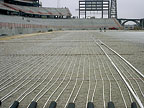
It's A Grass Roots Thing
Radiant turf warming systems are rapidly being integrated into the design of new and reconditioned professional field projects. "There's more to a radiant turf system than just installing tubing under the soil," Marshall said.Before a radiant design can be done, several factors must first be determined. "Among these," said Marshall, "are the actual soil conditions. Most professional fields are multilayered beginning with a solid base of compacted earth."
According to the experts at Gillette, this layer will typically contain the main drain lines that will pull excess moisture from the field. Everything in this layer is typically supported by a covering of 1/2 in. washed stone. Above this, is a layer of 3/8 in. pea stone or something like it.
"It's in this layer where the irrigation lines and radiant tubing are contained," said Brolin. The next layer is called the root mix layer; it contains a wide range of soil and sand mixtures. Each field will require a different root mix mixture depending on how the field is to be used, the abuse level, the turf conditions, and the type of turf used, to name a few.
A Many-Layered Challenge
"Each of these system's layers adds its own special tweak to the design of the radiant system. For the stone layers it's important to know what type of stone is to be used so a conductivity value of the material itself is known and can be accommodated," said Marshall.In addition to the physical properties of the stone, the material's "cut" plays a relatively important part. "Rough-cut stones tend to capture more air pockets than smooth ones," said Marshall. "The captured air pockets decrease the layer's ability to conduct energy. Most stone layers range between 20% to 40% air, give or take - amounting to a considerable amount of ‘insulation.'"
The root mix layer introduces an entirely new set of variables into the equation. Here's where all of the root growth takes place, the layer is scientifically - no, fanatically - fertilized, watered, and aerated. Of these, said Marshall, "Water is the most important factor. Most root mix layers will maintain anywhere between 30% to 50% moisture at any given time, depending on the turf that's used. Water helps to increase this layer's conductive ability, creating a much more even temperature distribution."
Understanding how each of these layers is constructed is just the beginning. The next step is to determine where the radiant tubing is to be placed. This decision is influenced by layer construction and also by how the field is to be maintained. Aeration is a key component. Different fields will require different aeration techniques, but one thing is the same: something must penetrate the field in the aeration process. The radiant tubing, and any irrigation equipment, needs to be deep enough not to be damaged or interfere with the aeration process. In most fields, the construction is such that the build-up is uniform, creating a "domed" effect as one looks across the field. This method helps with water control and also allows for even depth of all components.
According to Marshall, once the physical properties of the material and conditions and the tubing depth are determined, a preliminary radiant design is begun. This phase of the design process determines the amount of tubing required to cover the field, the Btu load, supply water/glycol temperature, and flow rates.
Finessing The System
The most critical part of the system's performance happens at the point where heat moves from the pipes to the root zone mix. Fluids in a pipe of up to 130° to 140° would be very hard on grass roots, so this became a key interest. If exposed to those temperatures, the roots would gradually die, root pathogens would proliferate and moisture would be pushed up to the surface where field-tenders least want it."So, we put a 1/4 in. double-washed stone ‘thermal blanket' on top of the heated PEX to separate the pipes from the roots," said Brolin. "This also disperses heat evenly, allowing it to migrate up into the root zone in a uniform way." By the time it reaches the field surface, the grass temperature is about 50°.
According to field experts, soil temperature tests at Gillette have been right on the money, with uniform heat at the 9-in.-deep root zone mix. And, there's minimal temperature variance throughout the whole zone.
The stone layer adds another advantage. Because it absorbs, disperses, and retains heat well, there's less cycling of the boilers that heat the system. This reduces fuel consumption.
"We found that, on a 25° day, the pumps are cycling only once every two hours, and the controls call for only a limited amount of new heat," said Brolin.
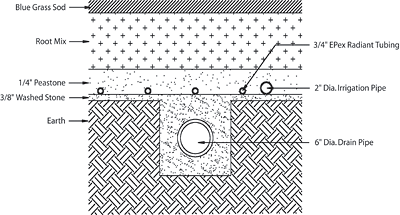
No Two Are Alike
Zoning a radiant turf warming system plays a critical role. It's influenced by mechanical constraints, such as how the supply and return lines are accessed, field abuse which areas need faster recovery and solar exposure, based on knowing when certain areas of the playing field will be warmed by the sun. The shape of the stadium and the shadow it casts chiefly determines the amount of solar exposure each section of the field receives.For the Patriots, a six-zone system was created, with three zones on either side of the 50-yard line. Tubing runs parallel to the sidelines, from the end zones to the midfield and back. Four-inch manifolds were installed along each end zone for the 3/4 in. WaterPEX to connect to.
According to Marshall, supply and return manifolds were installed in trenches along each end zone. Main supply and return lines were placed in trenches that ran along the sideline. The mechanical access is located in the corner of one of the end zones. Twelve 4-in. black iron supply/return lines access the mechanical room at one point.
"Each section of supply piping was welded together to minimize the potential for leaks, with expansion joints installed where necessary," said Marshall. "The lines were placed on 4 by 4 blocks to allow the lines to be rolled during the welding process.
"The manifolds are constructed of 20-ft sections of 4-in. K-type copper with fittings spaced to correspond to the WaterPEX installed in the field," he added. "Fittings consist of ball valves and 3/4-in. Crimp-Ring barbs. Ball valves were provided to assist in any purging that may need to take place. Each section was coupled together with the use of an expansion joint."
Once all of the manifolds were installed, it was time for the WaterPEX. Tubing lengths were 425 ft, which allow for the tubing to go from the manifolds to the 50-yard line and back, a round trip of 400 to 410 ft. Extra tubing was provided per circuit to allow for any manifold placement variances that may have occurred.
Amazingly: ±1° Temperature Control
Special factory-produced elbows were made to accommodate the curvature of the field. The tubing is secured to the field with the use of Watts Radiant RailWays and is spaced 8 in. on center. The RailWays are spaced every 15 ft across the field. According to Marshall, once the tubing was installed, the system was pressure tested. While the system was under the pressure test, sensors were installed in the field. Sensors allow for constant monitoring of the field temperature in various positions throughout each zone. "Control of each zone can now be maintained to within ±1°," said Marshall.The next step was the placement of the pea stone and the root mix. The root mix was installed with the use of a special conveyer system. This system kept any large equipment off the field until a sound base was applied that could carry the additional weight without damage occurring to the components placed below grade.
The mechanical system consisted of six Taco zone circulators and a DDC system. The DDC allowed for remote access to the system, remote monitoring, and history tracking. The zone load is approximately 10.5 million Btu and the total system load is nearly 12 million Btu. This load is supplied by an Alfa-Laval heat exchanger interfaced with the venue's power plant located in the stadium.
"Nothing will ever replace grass," concluded Brolin. "But you've got to have the system in place to support it. Every detail has to fall in place. It all comes down to quality control - the right plan, the right installers, and the right materials manufactured to perfection. Watts Radiant and Emerson Swan (the manufacturer's rep) helped us design and install what we're confident is a near-perfect system. ES
The Mechanical System
The stadium's boiler plant produces sufficient heat for the field. A 12 million Btu Alfa Laval plate-and-frame heat exchanger, located in the mechanical room, took heat from the boiler and transferred it to the field through a 50% propylene glycol/water mix. Field-side system temperature is controlled by a modulating control valve with outdoor reset, tied into the central DDC system provided by Sytec/Emerson Swan. The heated glycol/water mix is circulated to a zone pump station located closer to the field.The field was separated into six separate zones, each fed from the end zones, three zones on each half of the field. The center zones are smaller and cover only the area between the field marks approximately 50 ft wide. Brolin wanted this so that he could adjust soil temperature when repairs are made after a game. This selectively speeds the growth of grass without overheating undamaged areas of the field.
A circulating pump and modulating control valve serve each zone. Thirty-six sensors are located in the field, six per zone. These sensors read soil temperatures, sending signals to the control unit every 15 sec. These readings are averaged and sent to the central DDC computer. The result: modulating control valves respond quickly to keep the ground temperatures constant. Even variables such as wind, sun, rain, and snow have little effect on the ground temperatures at the root zone.
DDC
The control system is Novar's Savvy. It's networked back to a central processor to control, monitor, log, and alarm all facets of the operation. Brolin has a laptop computer connected to the Novar controller in his office. By modem, he can also monitor field conditions remotely. The system will send an alarm should any of the parameters fall out of limit. Alarming includes fax, e-mail, or calls directly to Brolin's cell phone or home phone.Trend logging is also an important benefit of the field's DDC system. Reports are generated routinely to show the comparison of weather patterns with soil temperatures at all 36 sensor locations. This helps to make temperature adjustments before adverse weather conditions.
The Novar Savvy controller actually remembers repetitive changes in conditions, anticipates the changes, and compensates for them. For instance: suppose zone six gets shady at 3 p.m. in December and the soil temperature starts to drop off at 5 p.m. The Novar Savvy will remember this drop, directing more energy toward that zone at, say, 1:30 p.m.
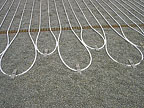
The Winning Team
Super Bowl ‘01 and ‘03 victories are proof that the Patriots know the team is strongest when its individual members are unified in all that they do. Setting a goal to build the best sports turf system in the NFL was no different. Here's how this team of professionals came together and won.Around the time Gillette Stadium officials set their sights on building the "field of dreams," Randolph, MA-based manufacturer's rep firm, Emerson Swan, was exploring an interest in the stadium field heating system. Timing is everything, as they say.
Emerson Swan began to call on the experts at Gillette, who took interest in their broad design, product, and application experience. Watts Radiant was chosen as the source for the all radiant heat technology, fittings, and accessories.
Dick Lucy, special projects manager for Emerson Swan, and in charge of the firm's new controls division, Sytec Controls, was appointed the role of overall project supervisor. Other members of the team included:
- Baltimore-based Yates & Co., and their controls subsidiary, YEM, together, had extensive NFL field heating experience;
- Plumbing and mechanical contracting firm, E.M. Duggan Co., Canton, MA, was chosen to do the installations; and
- E.D.E., an engineering firm from Waltham, MA, fast-tracked the overall field system design and got it on paper in less than 30 days.
